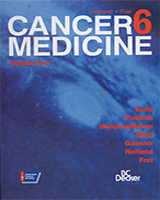By agreement with the publisher, this book is accessible by the search feature, but cannot be browsed.
NCBI Bookshelf. A service of the National Library of Medicine, National Institutes of Health.
Kufe DW, Pollock RE, Weichselbaum RR, et al., editors. Holland-Frei Cancer Medicine. 6th edition. Hamilton (ON): BC Decker; 2003.

Holland-Frei Cancer Medicine. 6th edition.
Show detailsFailure to achieve remission, that is, fewer than 5% blasts by day 29 of induction remains a consistent adverse prognostic factor. On the CCG 1988 to 1995 series trials, 1.6% of children survived induction with an M2 marrow (between 5% and 24% blasts) and 1.0% of children survived induction with an M3 marrow (more than 25% marrow blasts). M2 patients have 5-year EFS of 50%. Of M3 patients, one-third never achieve remission and have a dismal outcome and two-thirds ultimately achieve remission and have a 5-year EFS of 40%.59 The vast majority of relapses still occur among patients with an apparently good marrow response at the end of induction.
Day 8 and 15 marrow response continues to identify groups with disparate treatment outcomes60–64 (Table 141a-3). However, the day 15 response is relatively insensitive and “captures” no more than 12% to 27% of events on three recent CCG studies. Among a SR population with an 85% EFS, if 20% of events are found among the 10% of patients with a poor response on day 15, then the EFS for the better and worse response subsets are about 87% and 70%. The day 8 response data on four recent CCG studies are fairly consistent and somewhat more sensitive. The poor response group captures about 60% of events but is relatively nonspecific with a relative hazard less than 2. In a SR population with a 85% EFS, if 60% of events are found among the 50% of patients with a poor response on day 8, then the EFS for the better and worse response subsets are about 88% and 82%.
Table 141a-3
“Early” Marrow Response.
CCG has employed early marrow response to allocate therapy. On a past HR trial, Nachman and coworkers showed that many patients with more than 25% marrow blasts on Day 8 might be rescued with the Augmented Regimen.18 On the 1995 to 1999 SR CCG trial, patients with more than 25% marrow blasts on Day 15 are allocated to the Augmented Intensive Regimen. Benefit has now been demonstrated.65 Rescue has now been extended to all patients who are M3 on day 8 and M2 or M3 on day 15. The Berlin-Frankfurt-Munster (BFM) Group has similarly employed the peripheral blood response after one dose of methotrexate and one week of prednisone for treatment allocation.66 Successful rescue of slow response patients improves their outcome and abrogates the prognostic significance of early response. Conversely, lesser therapy may be adequate for rapid response patients. Data in one study suggest that SR patients with a rapid day 8 response may obtain a similarly excellent outcome with less extensive postinduction intensification, that is, one Delayed Intensification phase, whereas SR patients in general benefited from more extensive postinduction intensification, that is, two Delayed Intensification phases.17
The value of measures of response is limited by the quality of marrow samples and by the ability to identify residual leukemia. A dilute specimen may not be representative of marrow disease. Schultz and coworkers found substantial differences between estimates of marrow blast percentage based on marrow aspirates and biopsies.67 The burden of leukemia in a single marrow aspirate may not be representative because leukemia may be anatomically heterogeneous.68
Precise identification of marrow blasts on day 8 or 15 by light microscopy may be difficult. Thomson and coworkers found 3 of 15 day 8 marrows had fewer than 5% marrow blasts by microscopy and more than 25% marrow blasts by flow cytometry.69
- Morphological Response and Outcome - Holland-Frei Cancer MedicineMorphological Response and Outcome - Holland-Frei Cancer Medicine
Your browsing activity is empty.
Activity recording is turned off.
See more...